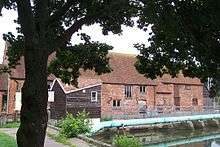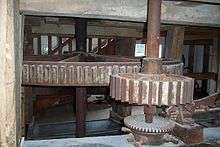Eling Tide Mill

Eling Tide Mill, situated on an artificial causeway in Eling in Hampshire, England, is one of only two remaining operating tide mills in the United Kingdom. The other is Woodbridge Tide Mill in Suffolk. Whilst a mill is mentioned in the Domesday Book of 1086, there is no evidence that there is any connection to the present mill. The current mill was rebuilt roughly two hundred years ago after storm damage in the 1770s.[1]
Overview



The tide mill has a pair of independent waterwheels designed to drive a millstone each. One wheel produces flour for sale, the other is kept as a static exhibit. The running wheel and its milling and other mechanisms are encased for safety of miller and visitors, the static wheel is immobile and kept that way to show visitors the detail that is obscured by the running mechanism's safety enclosures. The mill can be productive for between five and seven hours each day.[2]
History
The mill's history until the 1960s is recounted by J.P.M. Pannell.[3] For much of the mill's life it was owned by Winchester College. A lease survives from the year 1418, when the College leased the mill to Thomas Mydlington, requiring him to maintain the mill and the causeway. The causeway was prone to collapse, for example it washed away in 1887.[4] This continued up until 1940 when modern engineering calculations revealed the cause to be the design of the sluices. This was then corrected.
According to Pannell (p16), The tenancy of the mill included the right to collect tolls from vehicles using the causeway. In 1967, the toll collector was Tom Mackrell who had been the last miller to operate the mill when it closed in 1946. Having been out of action since then, the mill reopened in 1980.[1]
References
- 1 2 "Eling Tide Mill History". Archived from the original on 2007-11-17. Retrieved 2012-01-19.
- ↑ Spain, Rob: "A possible Roman Tide Mill", Paper submitted to the Kent Archaeological Society, page 34
- ↑ Pannell, John Percival Masterman (1967). "Tide Mills". Old Southampton Shores, Newton Abbott. David and Charles. p. 196. ASIN B0000CNGOE.
- ↑ "Eling... The Causeway". Hampshire Advertiser. 2 April 1887 – via British Newspaper Archive. (subscription required (help)).
External links
| Wikimedia Commons has media related to Eling Tide Mill. |
- Eling Tide Mill
- Former website "Eling Tide Mill". Archived from the original on 2007-12-17. Retrieved 2009-04-14.
- The Rarest Tide Mill by David Plunkett, Proceedings of the First Mill Research Conference, 1983
Coordinates: 50°54′40″N 1°28′56″W / 50.9110°N 1.4821°W